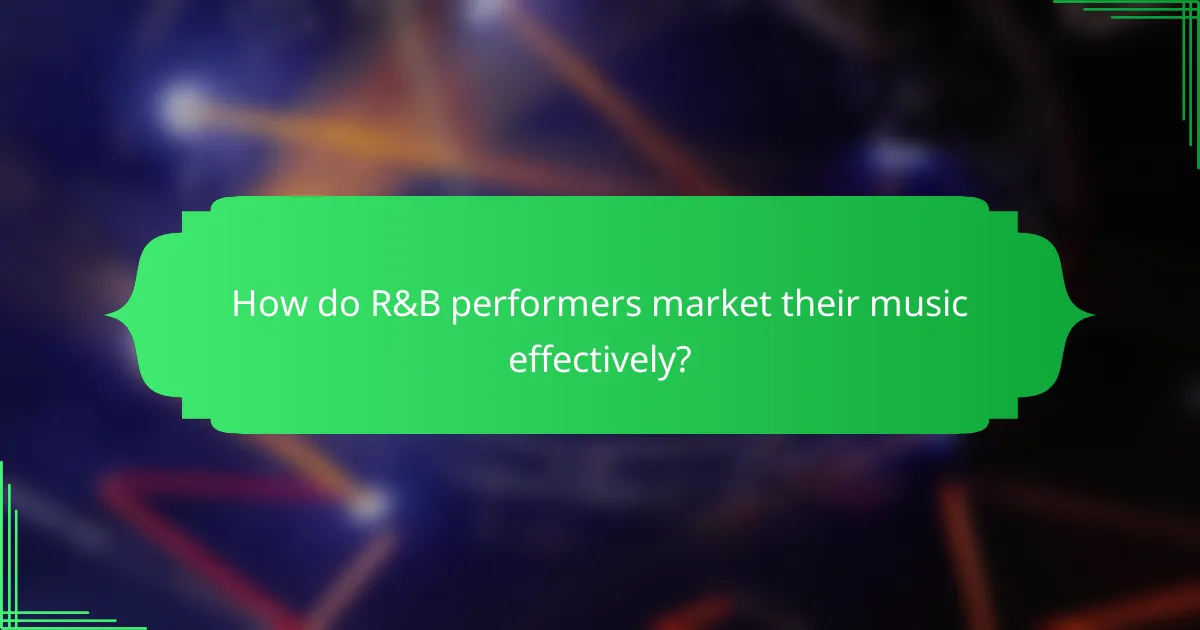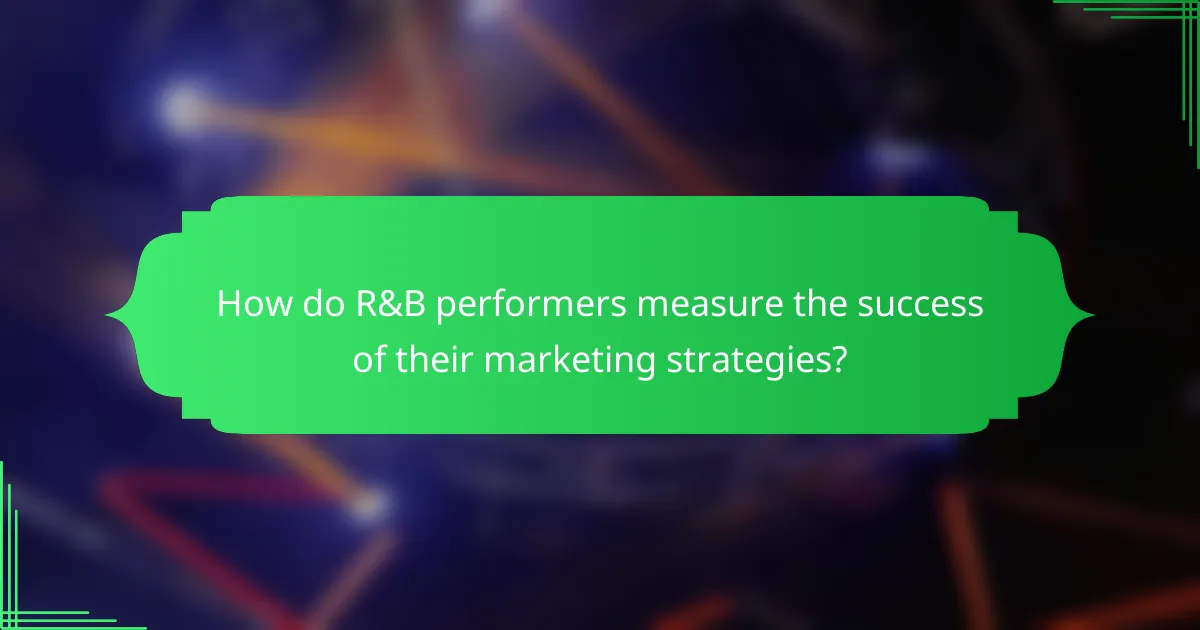R&B performers face a diverse range of production costs influenced by their experience and the scope of their projects, including expenses for studio time, music videos, and distribution. To effectively market their music, artists utilize social media, influencer collaborations, and live performances, which help them connect with audiences and boost sales. Additionally, touring budgets can vary significantly, often reaching from tens of thousands to millions of dollars, depending on the artist’s popularity and the scale of the tour.

What are the production costs for R&B performers in Canada?
Production costs for R&B performers in Canada can vary widely based on the artist’s experience, project scope, and market conditions. Key expenses include studio recording, music video production, album distribution, equipment, and collaboration fees.
Studio recording expenses
Studio recording expenses typically range from a few hundred to several thousand Canadian dollars per day, depending on the studio’s reputation and location. Artists should consider the length of recording sessions, as longer sessions can significantly increase costs.
Additionally, hiring experienced sound engineers or producers can add to the budget. It’s advisable to plan for pre-production costs, such as arranging rehearsals and demos, which can also impact the overall recording budget.
Music video production costs
Producing a music video can cost anywhere from a few thousand to tens of thousands of Canadian dollars. Factors influencing the budget include the video’s concept, location, and production team. Simple videos may be more affordable, while high-concept productions with special effects can drive costs up considerably.
Artists should also factor in post-production costs, such as editing and visual effects, which can add several thousand dollars to the final bill. Collaborating with local filmmakers can help manage expenses while still achieving a professional look.
Album distribution fees
Album distribution fees for R&B performers in Canada often involve a combination of upfront costs and royalties. Digital distribution services may charge a flat fee or take a percentage of sales, typically ranging from 15% to 30% of revenue.
Physical distribution, if applicable, includes costs for manufacturing CDs or vinyl, which can add up quickly. Artists should research various distribution platforms to find the best fit for their budget and audience reach.
Equipment and instrument costs
Investing in quality equipment and instruments is essential for R&B performers. Costs can vary significantly based on brand and quality, with basic setups starting at a few hundred dollars and professional-grade gear reaching into the thousands.
Artists should prioritize essential items like microphones, mixers, and instruments, and consider renting high-end equipment for specific projects to manage costs effectively.
Collaboration and feature artist fees
Collaborating with other artists can enhance an R&B project but may come with additional costs. Feature artists often charge fees that can range from a few hundred to several thousand Canadian dollars, depending on their popularity and market value.
When planning collaborations, it’s crucial to negotiate clear terms upfront, including payment, rights to the music, and how the collaboration will be promoted. This can help avoid misunderstandings and ensure a smooth partnership.

How do R&B performers market their music effectively?
R&B performers effectively market their music by leveraging a combination of social media, influencer partnerships, streaming platforms, email campaigns, and live performances. These strategies help them reach a wider audience, engage fans, and drive sales.
Social media marketing strategies
Social media is a crucial tool for R&B performers to connect with fans and promote their music. Platforms like Instagram, TikTok, and Twitter allow artists to share content, announce releases, and interact directly with their audience. Regular posting and engaging content can significantly boost visibility and fan loyalty.
Using targeted ads on these platforms can also enhance reach. Setting a budget of a few hundred to several thousand dollars can yield substantial returns, especially when promoting new singles or albums.
Influencer partnerships
Collaborating with influencers can amplify an R&B artist’s reach. Influencers can introduce the artist’s music to their followers, often leading to increased streams and sales. Choosing influencers whose audience aligns with the artist’s target demographic is essential for maximizing impact.
Partnerships can take various forms, from sponsored posts to exclusive listening parties. Budgeting for these collaborations typically ranges from a few hundred to several thousand dollars, depending on the influencer’s reach and engagement levels.
Music streaming platform promotions
Music streaming platforms like Spotify and Apple Music offer promotional tools that R&B performers can utilize to enhance their visibility. Artists can submit their tracks for playlist consideration, which can lead to significant exposure and increased listener numbers.
Additionally, investing in targeted ads on these platforms can help reach potential fans. A budget of a few hundred dollars can be effective for localized campaigns, while broader campaigns may require a larger investment.
Email marketing campaigns
Email marketing remains a powerful way for R&B performers to communicate directly with their fans. Building an email list allows artists to share exclusive content, announce new releases, and promote upcoming shows. Regular newsletters can keep fans engaged and informed.
To create effective campaigns, artists should focus on compelling subject lines and engaging content. Using platforms like Mailchimp or Constant Contact can streamline the process, with costs typically starting at low monthly fees based on the number of subscribers.
Live performance promotions
Live performances are a key promotional strategy for R&B artists, providing opportunities to connect with fans and showcase their music. Promoting concerts through social media, local media outlets, and email newsletters can drive ticket sales and increase visibility.
Collaborating with local venues for promotional support can also enhance reach. Artists should consider budgeting for promotional materials, such as posters and online ads, which can range from a few hundred to several thousand dollars depending on the scale of the event.

What are the touring budgets for R&B artists?
The touring budgets for R&B artists can vary widely based on factors like the artist’s popularity, tour scale, and locations. Typically, these budgets can range from tens of thousands to several million dollars, depending on the scope of the tour.
Venue rental costs
Venue rental costs are a significant part of an R&B artist’s touring budget. Prices can vary based on the venue’s size and location, with smaller venues costing a few thousand dollars and larger arenas potentially exceeding hundreds of thousands. Artists should consider not only the rental fee but also any additional charges for utilities and equipment.
Touring crew salaries
The salaries of the touring crew, including sound engineers, roadies, and lighting technicians, contribute substantially to the overall budget. A typical crew can range from a handful to dozens of members, with salaries varying widely based on experience and role. For instance, a sound engineer might earn between $1,000 to $3,000 per show, while support staff may earn less.
Transportation and logistics expenses
Transportation and logistics expenses encompass costs for moving equipment and crew between venues. This can include bus rentals, flights, and freight for instruments and gear. Depending on the tour’s length and distance, these costs can add up quickly, often reaching tens of thousands of dollars.
Merchandise production costs
Merchandise production costs are essential for generating additional revenue during tours. Items like t-shirts, hats, and posters must be produced and can cost anywhere from a few dollars to over $20 per item, depending on quality and design. Artists should plan for these expenses to ensure they can offer appealing products to fans.
Insurance and security fees
Insurance and security fees are critical for protecting both the artists and their assets during tours. Liability insurance can cost several thousand dollars, while security personnel may be required at venues, adding to the budget. It’s crucial to factor in these costs to avoid unexpected financial burdens during the tour.

What criteria should R&B performers consider when planning a tour?
R&B performers should consider factors such as target audience demographics, market demand, and effective tour routing when planning a tour. These elements help ensure that the tour is profitable and reaches the right fans.
Target audience demographics
Understanding the demographics of the target audience is crucial for R&B performers. This includes age, gender, income level, and geographic location, which can influence ticket pricing and venue selection. For instance, younger audiences may prefer smaller, intimate venues while older fans might opt for larger arenas.
Performers can gather demographic data through social media analytics, streaming platforms, and previous concert attendance records. Tailoring marketing efforts based on this data can enhance engagement and ticket sales.
Market demand analysis
Market demand analysis involves assessing the popularity of the performer and the genre in specific regions. This can be done by examining streaming numbers, social media engagement, and ticket sales from previous tours. Identifying high-demand areas can help maximize attendance and revenue.
R&B performers should also consider competing events and local music trends. For example, if a major festival is happening nearby, it might affect ticket sales. Planning around such events can help avoid conflicts and increase audience turnout.
Tour routing and scheduling
Effective tour routing and scheduling are essential for minimizing costs and maximizing exposure. Performers should create a logical route that reduces travel time and expenses, ideally clustering shows in nearby cities. This can help keep touring costs manageable.
Scheduling should also consider local holidays, school breaks, and other events that might affect attendance. For example, touring during summer months may attract larger crowds, especially in outdoor venues. Balancing these factors can lead to a more successful tour overall.

How do R&B performers measure the success of their marketing strategies?
R&B performers measure the success of their marketing strategies through various metrics, including album sales, streaming numbers, social media engagement, and concert ticket sales. These indicators help artists and their teams assess the effectiveness of their promotional efforts and adjust strategies accordingly.
Key Performance Indicators (KPIs)
Key Performance Indicators (KPIs) for R&B performers typically include album sales, digital downloads, and streaming statistics. Monitoring these metrics allows artists to gauge their reach and popularity in the market. For instance, a significant increase in streaming numbers may indicate a successful marketing campaign.
Social media engagement is another crucial KPI. High levels of likes, shares, and comments on platforms like Instagram and TikTok can reflect audience interest and engagement. Artists often track follower growth and interaction rates to measure their marketing effectiveness.
Audience Feedback and Surveys
Audience feedback plays a vital role in assessing marketing success. R&B performers often use surveys or social media polls to gather insights about fan preferences and perceptions. This direct feedback can inform future marketing strategies and help tailor content to meet audience expectations.
Additionally, analyzing comments and reviews on platforms like YouTube or music streaming services can provide valuable qualitative data. Positive feedback may indicate that marketing efforts resonate well with fans, while negative comments can highlight areas needing improvement.
Sales and Revenue Analysis
Sales and revenue analysis is essential for R&B performers to evaluate the financial impact of their marketing strategies. This includes examining ticket sales from tours, merchandise sales, and streaming revenue. A successful marketing campaign should ideally lead to increased sales across these areas.
Performers often compare revenue before and after marketing initiatives to determine effectiveness. For example, a well-promoted album release may lead to a noticeable spike in both album sales and concert ticket purchases, indicating a successful strategy.
